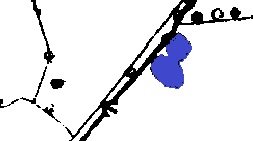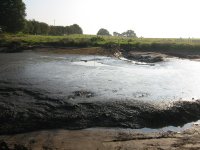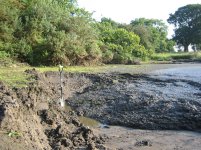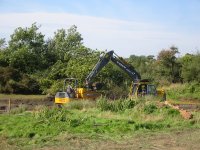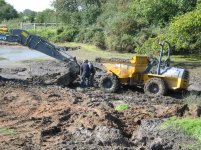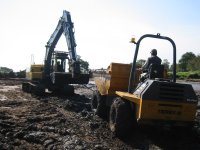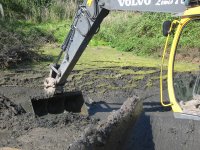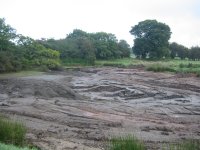Dig Day 2
The mud had slumped a little overnight in places where the mud had been deepest, but the bulk of the exposed clay was almost dry.
I have seen excavators with extra long booms and no doubt these would have helped reach out a little further. Our plan of attack for that second day didn't need a particularly long boom. The excavator would work gradually to the centre and as it progressed cut out a smooth path down to hopefully more firm clay so the dumpers could come down into the hole to meet the excavator. That way the excavator would not be wasting time tracking back and forth, all it needed to do was swing round to empty it's bucket.
A small ramp was cut into the bankside and down into the hole went the first dumper. To everyone's relief the clay base help up well and we soon settled into a steady routine.
The amount of material coming out was impressive and it became an issue of where to put all the stuff without wasting time driving too far. I cut the wire on the fence to the adjacent field and we poured the gloop out of the dumper buckets onto the ground. My intention at the time was to spread it thinly over the grass in the fields at a later date. Like many of my good intentions, that hadn't happened even by the following year, by which time it was easier to plant a few trees on the top and pretend this was all part of the plan to improve local biodiversity.
Eventually the firm clay base decided it had enough of us rolling over the surface and it started to rut. We began to slip and slide as we reversed out with our loads. When we originally planned the dig we had talked of getting some swamp mats for the sticky stuff, however in the haste to rearrange things these had been forgotten. At first it only needed an occasional gentle nudge from the excavator bucket to get the dumper moving up the grade and we carried on working like that for some time.
Four wheel drive dumpers are designed to work in mud, but once the wheels are constantly spinning you know they have about reached their limit. I thought I would be the first to get stuck, but as I made my last return trip before lunch I saw the first dumper had slipped sideways and now needed some more serious assistance to get out.
They had a chain on it almost before I had chance to snap a photo and some steady pulls had it out again.
Time to move away from that spot before we got seriously stuck. Another ramp was cut and for the rest of the day we steadily ate away at the mud pie.
When we started I had no idea how deep the mud would go. By the end of the day we the deepest points were now at least 6' below the old water level.
Dig Day 3
We didn't move as much mud on that third day. All the easy digging had been had and now were down to scoop a bucket of slop and then track right back before swinging round and pouring into the waiting dumper. In the end, we didn't quite make it to the far bank, but we had dug out enough for this to be a proper pond again for some time to come.
With Hindsight
So that's what we actually did. If I'd found tbn back then and asked you all for help, how else could we have done it ?
.
